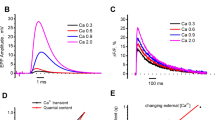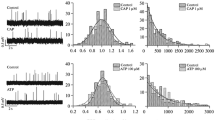Abstract.
Previously, we have presented evidence for the presence of L-type voltage-dependent Ca2+ channels (VDCC) in 1,2-bis(2-aminophenoxy)ethane-N,N,N′,N′-tetraacetic acid, (acetoxymethyl)ester (BAPTA-AM)-incubated motor nerve terminals (MNTs) of the levator auris muscle of mature mice. The aim of the present work was to study the coupling of these L-type VDCC to neurotransmitter release by inhibiting protein phosphatases. We thus studied the effects of the protein phosphatase inhibitors okadaic acid (OA) and pervanadate on quantal content (QC) of transmitter release with the P/Q-type channels fully blocked. The QC was not significantly different under the three experimental conditions tested: incubation with dimethylsulphoxide (DMSO), ethyleneglycol-bis(β-aminoethylether)-N,N,N′,N′-tetraacetic acid, (acetoxymethyl)ester (EGTA-AM) and BAPTA-AM. After preincubation with OA (1 µM), but not with pervanadate, QC increased substantially in the BAPTA-AM-incubated (up to 400%) MNT, but not in those incubated with DMSO or EGTA-AM. The OA-induced increment of QC was attenuated greatly (~95% reduction) by preincubation with either nitrendipine (10 µM) or calciseptine (300 nM). The effect of OA (1 µM) and pervanadate (0.1 mM) on spontaneous neurotransmitter release was also studied. After preincubation with OA, but not pervanadate, miniature end-plate potential (MEPP) frequency increased only in the BAPTA-AM-incubated MNT (up to 700% increment). This response was attenuated (by ~80%) by nitrendipine (10 µM) or calciseptine (300nM). In contrast, neither ω-agatoxin IVA (120 nM) nor ω-conotoxin GVIA (1 µM) affected this OA-induced increment significantly. We also evaluated the relationship between QC and extracellular [Ca2+] ([Ca2+]o) in BAPTA-AM-incubated MNT. Under conditions in which only P/Q-type VDCC were available to participate in neurotransmitter release, QC increased as [Ca2+]o was raised from 0.5 to 2 mM. However, when only L-type VDCC were available, QC increased when [Ca2+]o increased from 0.5 to 1 mM, but decreased significantly at 2 mM. The mean latency for P/Q-type VDCC-mediated EPP was 1.7–1.9 ms; for L-type VDCC-mediated EPP, 1.9–2.5 ms. The rise time of the L-type VDCC mediated EPP was significantly slower than that mediated by P/Q-type VDCC. Preincubation with H-7 (100 µM), a potent inhibitor of protein kinase C (PKC) and adenosine 3′,5′-cyclic monophosphate (cAMP)-dependent protein kinase (PKA), attenuated the OA-induced increment of both QC and MEPP frequency (50% and 70% decrement, respectively), suggesting the participation of at least these two protein kinases in the coupling of L-type VDCC. In summary, our results show coupling of L-type VDCC to neurotransmitter release when protein phosphatases are inhibited and intracellular [Ca2+] is buffered by the fast chelator BAPTA.
Similar content being viewed by others
Author information
Authors and Affiliations
Additional information
Electronic Publication
Rights and permissions
About this article
Cite this article
Urbano, F., Depetris, R. & Uchitel, O. Coupling of L-type calcium channels to neurotransmitter release at mouse motor nerve terminals. Pflügers Arch - Eur J Physiol 441, 824–831 (2001). https://doi.org/10.1007/s004240000489
Received:
Accepted:
Issue Date:
DOI: https://doi.org/10.1007/s004240000489




